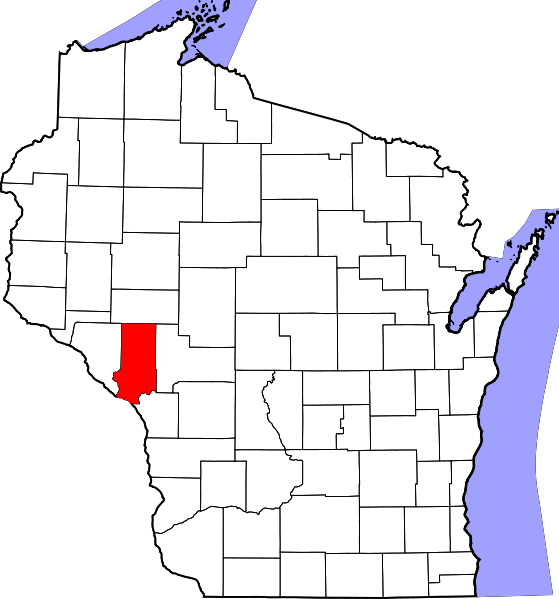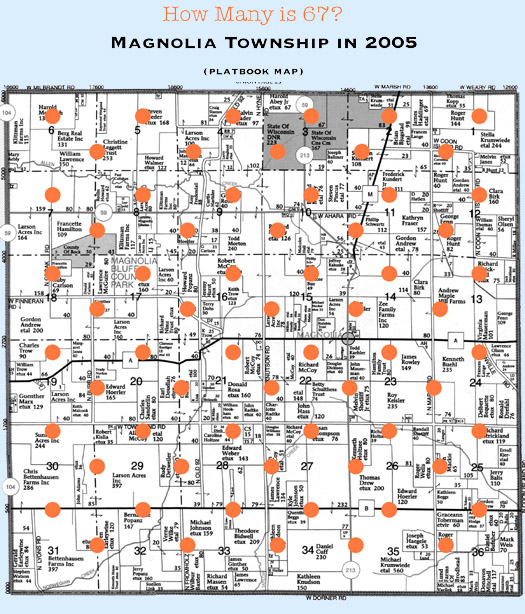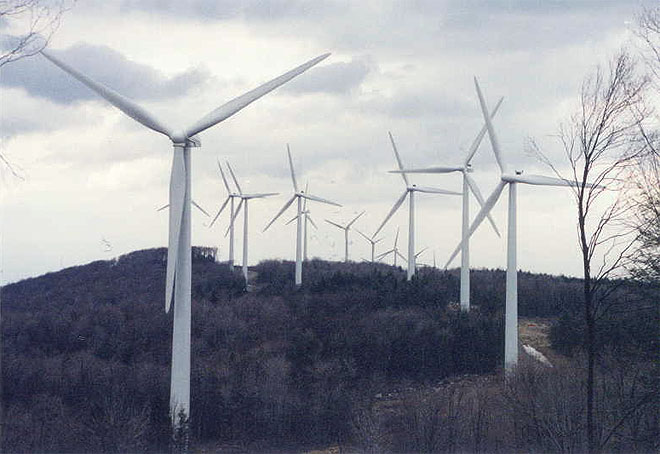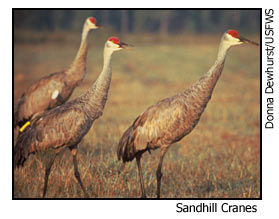2/2/08 How Union Township's Draft Wind Ordinance May Change Things
 Union wind recommendations could be used in state discussions
Union wind recommendations could be used in state discussions
By GINA DUWE
Saturday, Feb. 2, 2008
The Janesville Gazette (click here to read article)
UNION TOWNSHIP — A draft wind ordinance developed by a town of Union committee should be an example state officials consider during discussions of state wind turbine siting standards, state Rep. Brett Davis said.
Because wind energy regulation is a controversial statewide issue, Davis said he will push for a legislative council study committee to discuss the issue.
“I think there are so many competing interests that are involved from all different sides that everyone needs to sit down at a table and really work through this,” he said.
Davis, R-Oregon, met with members of the Town of Union Wind Study Committee over the past few months while they researched and developed a draft ordinance regulating wind energy. Committee chair Tom Alisankus presented the recommendations to the plan commission Thursday night.
Wind turbines in the township would need to be at least one-half mile from homes and 1,000 feet from property lines, according to the committee’s draft ordinance.
“I think the people that were working on the ordinance did a good job in terms of the background and reasoning,” Davis said. “(They) based and grounded it in fact.”
The town of Union committee’s recommendations should be considered if a state committee is formed, he said, and local residents could sit on such a committee.
Davis said he’s not suggesting the state come up with specific regulations, but said the state’s model ordinance is potentially outdated.
The Union committee brought legitimate questions to the state on how it developed the model ordinance, Davis said, and officials could not answer them appropriately.
“Which raises some red flags and needs to be revisited in terms of how to move forward,” he said.
State officials and interested parties met this week to discuss establishing a process for a state model, similar to the state’s new livestock siting law, said Richard Stadelman, executive director of the Wisconsin Towns Association.
Stadelman has reviewed the town of Union’s proposed ordinance and said it is very detailed. Since the setbacks are less than other ordinances in the state, he said the proposal would be more defendable.
Trempealeau County, for example, passed an ordinance in December with setbacks of 1 mile from homes, he said.
But Curt Bjurlin, Wisconsin project developer for EcoEnergy, said the proposed setbacks eliminate any land in Union Township for a wind energy project. EcoEnergy is proposing to build three turbines there.
“We think the draft ordinance that was presented was designed to ensure that the project wouldn’t go forward—that the status quo of how we make energy today would continue,” he said.
Alisankus disagreed, saying that’s the opposite of what happened.
When he was asked to chair the committee, Alisankus said he did so with the agreement that personal feelings would be put aside and the facts of the research would be the basis for recommendations.
The committee wanted its ordinance to be able to withstand challenges from the wind industry, so it had outside lawyers review it and let the facts lead the discussion, he said.

2/2/08 Gambling on a 40 story turbine. Are all the kinks worked out? What happens if it doesn't work?
Wind power on hold
February 2, 2008 by Julie Buntjer Worthington Daily Globe
(Click here for web link)
Officials with the wind farm, developed by Clipper Wind, discovered late last summer there was a timing issue in the secondary stage of the power train.
"It was ... what we would call a start-up issue - supplier related," said Mary McCann-Gates, director of global communications for Clipper Wind's Carpinteria, Calif., office. "In a nutshell, some of the power trains that we made early on had a timing issue on some of the gears."
To prevent further damage to the gears, McCann said the affected turbines were shut down. The process to replace the drive trains with correctly-timed gears is ongoing, and she doesn't yet know how soon the repairs will be completed.
"As we bring one down, we have a new one that has arrived from the manufacturing facility that we're putting right up there," she said. "All of the turbines at Endeavor don't have the same gear timing issues. Some of them are just fine."
McCann said that as workers replace the power trains, they are also making reinforcements on the blades.
"These blades have to last 20 to 25 years," McCann said. "Since we have the blades down, we feel we have the opportunity to reinforce these blades."
The biggest challenge - and the greatest delay in completing repairs - is the weather, McCann said.
"Working on these blades, the fiberglass material has to set properly; it has to be heated to a certain temperature for it to cure properly," she said. "It's a very precise process. While it's not going to take a tremendously long time, we want to take the time to do it properly."
Both the affected blades and power trains were manufactured at Clipper Wind facilities in Iowa.
McCann said the components, developed for the 2.5 megawatt Liberty C93 wind turbines, began being mass produced in 2007.
"It's like with anything. You see this with cars where you have a recall here or a fix there," McCann said. "This is our first production of a brand new turbine. With a new product, there will be some teething issues."
Despite the "teething issues," McCann said there hasn't been anything wrong with the design of the turbines. The power train timing issue has been corrected by the manufacturer, and the change has been implemented in all of the new blades coming out of the factory, she added.
"For the most part, it's a fabulous project," she said. "These are turbines that have been built in Iowa, installed in Iowa, and they are the largest turbines built in the U.S."
The Endeavor Wind Farm at Harris was purchased by Florida Power & Light in August 2007. Because of the repairs Clipper Wind must make, the acquisition process has not yet been completed.
2/1/08 What's the Connection With Sleep Disruption and Adult-Onset Diabetes And What Does This Have To Do With Wind Turbines?

NEW STUDY LINKS DISRUPTED SLEEP WITH ADULT-ONSET DIABETES
There are several stages of sleep, and deep sleep is considered to be the most restorative to our bodies.
A January 22nd 2008 report from the National Academy of Science suggests a link between adult-onset diabetes and poor sleep quality, including disruptions that pull us out of deep sleep but don't awaken us.
One of the biggest problems for those living close to industrial wind turbines is disrupted sleep from noise, which tends to be louder at night.
This study suggests that even if you manage to sleep though disruptive noise, it affects the quality of your sleep and that affects your health. There are a lot of problems associated with disrupted sleep. The recent link to adult-onset diabetes is just one of them.
Science News Online
Week of Jan. 19, 2008; Vol. 173, No. 3
Sleep disruption and glucose processing
Nathan Seppa
(Click here to read article at its souce)
Shallow sleep can impair a person's glucose metabolism, despite the presence of adequate insulin, researchers report. The finding might explain previous studies that linked poor sleep patterns with type 2, or adult-onset, diabetes, since the disease is closely tied to such insulin resistance.
Researcher Esra Tasali of the University of Chicago monitored nine healthy volunteers during two nights of sleep. She also used blood tests to measure each participant's ability to process intravenous infusions of glucose the next morning. A month later, Tasali repeated the tests over three nights. But this time, researchers set off a noise whenever a participant entered a deep form of sleep thought to be the most restorative. The disruptions pull people back from deep sleep but don't awaken them.
The blood tests showed that eight of the nine volunteers had significantly poorer glucose processing the day after being deprived of deep sleep. In these people, insulin-making cells in the pancreas failed to rev up production in response to this substandard glucose metabolism, Tasali and her colleagues report in the Jan. 22 Proceedings of the National Academy of Sciences.
Earlier work had linked a lack of sleep with poor glucose metabolism. But the new study goes a step further, associating poor quality sleep with the condition. The participants got just as many hours of sleep during their routine nights as they did during the noisy experimental nights.
The findings suggest that deep sleep has an effect on hormones.
(Read the National Academies of Sciences Abstract by clicking here)
1/30/08 Bullied By a Boy Named SUE: What Happens When A Wisconsin County Passes an Ordinance a Wind Developer Doesn't Like?
 IS TREMPEALEAU COUNTY BEING MENACED BY A BOY NAMED "SUE" FOR PROTECTING ITS RESIDENTS?
IS TREMPEALEAU COUNTY BEING MENACED BY A BOY NAMED "SUE" FOR PROTECTING ITS RESIDENTS?
Does a wind developer have the right to threaten an entire county for passing a wind energy ordinance that protects the residents of that county? Aren't ordinances intended to protect residents rather than favor developers? If the research shows that human health and safety is affected by irresponsible siting of wind turbines, and if a county creates an ordinance that favors the health and safety of its residents over the success of a wind developer's plans, should they then be threatened with a lawsuit?
Wind farm tempest blows through Trempealeau; Developer considers suing county over ordinance
(read the article at its source by clicking here)
Trempealeau County's wind farm ordinance hasn't yet generated a lawsuit, but that might be AgWind Energy Partners LLC's only choice.
At least that's how Jordan Hemaidan of Madison-based Michael Best & Friedrich LLP sees it.
"There are many considerations that have to go into when or whether or not to file a lawsuit," he said. "AgWind is not pursuing one at this time, but it reserves the right to bring a lawsuit forward at the time of its choice."
Hemaidan represents the Holmen-based wind farm developer and, earlier this month, he sent a letter to county officials saying judicial review of the ordinance and a court order overturning it could be in order.
Jim Naleid, AgWind's managing director, opposed the county's ordinance when it passed at the end of November because it placed a vast amount of restrictions on wind farm development.
The ordinance requires that developers place wind turbines at least one mile from neighboring residences, schools, hospitals and businesses. It is the longest setback distance imposed to date by a Wisconsin government.
"There is not one square inch of land," Naleid told the County Board in December, "where a commercial wind turbine can be legally sited under this ordinance."
Hemaidan said the legal problem is state law requires that restrictions on renewable-energy development only be established in lieu of public health or safety concerns, if the restrictions don't significantly increase or decrease efficiency costs, or if they allow for alternative and comparable systems.
"It is our belief," Hemaidan said, "that any court reviewing (Trempealeau County's ordinance) would have the basis to conclude that many of the requirements were not developed in faithfulness to public health and safety."
But Greg Leonard, the county's Department of Land Management director, said public safety was the only thing taken into consideration by the citizens committee that drew up the ordinance.
"All the setbacks were established," he said, "with public safety in mind."
The committee did not review if the ordinance would effectively restrict any wind farms from being built in the county, Leonard said, because that was not its charge. He added that he didn't know the extent of the restrictions because he had a tough time reading the colors on the accompanying map of the county.
AgWind installed a meteorological tower in the county to measure wind speeds last year with an eye on pursuing a wind farm development.
Leonard would not comment on what specifically triggered the committee to draft the ordinance, but he said committee members worked on it for a long time.
Ryan Schryver, energy policy specialist with Clean Wisconsin, said counties that put in extensive restrictions on renewable-energy development run the risk not only of lawsuits from developers, but also intervention from the state.
"(Trempealeau County) effectively eliminated any possible development there," he said. "Wisconsin is moving in a direction toward more renewable energy and less dependence on coal, and it could get to a point where the state or region steps in and says, ‘You can't put ordinances like that in place.'"
While the state isn't legally allowed to do that, the law could be changed, said Eric Callisto, executive assistant to Public Service Commission Chairman Dan Ebert.
"There is a definite possibility in looking at the issue as a statewide initiative," he said. "Whether or not something happens this session, I can't say. This session ends in March, so something would have to be done quickly, but there could yet be a real dialogue about it."
Given Gov. Jim Doyle's steadfast views on growing renewable energy throughout the state and the positive economic effects renewable-energy developers generate, municipalities need to leave their doors open to all possibilities, Callisto said.
"Putting out a message that renewable energy is not welcome in Wisconsin is a mistake," he said. "We can't and don't want to be sending out mixed signals on that."
1/29/08 How to Fit 67 Turbines into 36 Square Miles
Let Each Orange Dot
Equal One 40 Story Turbine
EcoEnergy is unable to give us a map of where the 67 turbines proposed for Magnolia township would go, but just to get an idea of how many turbines we're talking about we thought we'd spread them out evenly across the entire township. Each turbine will be 40 stories tall and have a wing span wider than a 747. This map has 66 dots. Where would you put the 67th?


1/26/2008 What's This I Hear About a Wolf In Green Clothing Moving in on the Horicon Marsh?
While Union Township prepares to hear the public presentation of its Wind Turbine Study Committee findings this Thursday, January 31, 7 pm Eager Public Library, 39 W. Main Street, Evansville--- and while wind developers, EcoEnergy, will be hosting an open house this Monday from 5:50-8:30 at McKenna Middle school to "educate" attendees about the difference between the Union and Magnolia township proposals, (three turbines vs sixty seven turbines), 400 foot turbines are going up RIGHT NOW along the Horicon Marsh. Why should we care?
Wind Farm Threatens Horicon National Wildlife Refuge
(Visit The Refuge Watch Website and read this article at its source by clicking here. )
 The Fond du Lac Reporter in southeastern Wisconsin is reporting that the Horicon Marsh Systems Advocates — an environmental advocacy group — has pledged to closely monitor the wind farm that will soon be built at least two miles from Horicon National Wildlife Refuge in Wisconsin.
The Fond du Lac Reporter in southeastern Wisconsin is reporting that the Horicon Marsh Systems Advocates — an environmental advocacy group — has pledged to closely monitor the wind farm that will soon be built at least two miles from Horicon National Wildlife Refuge in Wisconsin.
The HMS Advocates have been fighting the wind farm project for some time, as they worked to ensure the company would be forced to build the turbines at least five miles from the eastern edge of Horicon NWR, so as not to interfere with moving bird populations. According to the HMS Advocates’ website:
In the summer of 2004, Forward Energy submitted an application to the Wisconsin Public Service Commission for the construction of a wind center consisting of 150 wind turbines. The wind center will cover an area consisting of the towns of Lomira, Byron, Leroy, Brownsville and Oakfield. This encompasses an area of 33,000 acres next to the Horicon Marsh. HMS Advocates feel that this project will have a devastating effect on the projected area.
HMS Advocates is not opposed to the idea of renewable energy sources. However, the organization feels that the proposed location is devastating to a prized area in our state. The Horicon Marsh is unique source of wildlife to our nation. Here are some things that make the Horicon Marsh special:
- Horicon Marsh is the largest freshwater cattail marsh in the US
- Renowned for its migrant flocks of Canada geese, it is also home to more than 260 species of birds
- Due to its importance to wildlife, Horicon Marsh has been designated as
- “Wetland of International Importance”
- “Globally Important Bird Area”
- Both a state wildlife area and national wildlife refuge
With their last legal battle fought, the HMS Advocates are now preparing for Invenergy Wind LLC to have 86 turbines operating by May at the $250 million Forward Wind Energy Center. According to the Fond du Lac Reporter, the HMS Advocates will now commit themselves to monitoring the impact of the turbines:
“We plan to monitor the project and bring news of bird kills to the attention of the media and U.S. Fish and Wildlife Services to push for charges in accordance with the Bird Migratory Treaty Act,” said Curt Kindschuh, public information officer for Horicon Marsh Systems Advocates. “The death of Sandhill cranes, Canada geese, eagles, hawks, any migratory bird at all could result in significant state and federal fines for Invenergy or the hosting landowners.”
Among the most likely victims are sandhill cranes and local bat populations. The National Wildlife Refuge Association — which supported at least a four-mile setback for the wind farm — submitted comments for the project’s Environmental Impact Statement back in 2005, and stated:
..we understand that the total elimination of avian mortality under these circumstances is impossible, but the risk to some species of concern is particularly troubling. For example, Sandhill Cranes at Horicon National Wildlife Refuge use not only the marsh itself but also surrounding farmland for feeding and assembling (a majority using areas within three miles from the refuge boundary). Concern for this operating buffer is important. Not surprisingly, more Sandhill Cranes have been observed in the western portions of the current turbine zone. Indeed, hundreds of Sandhill Cranes use a few of the same fields (in the fall) where turbines are planned. It is unknown how they will adjust, if at all. The status of experimental Whooping Cranes should also be considered. If cranes from the Wisconsin experimental flock become established at or near Horicon Marsh, the site will become the focus of intense national and international conservation efforts. The largest gathering of migrating Canada Geese in the world (200,000 to 300,000 in the fall) may be secure, but close placement of turbines to Horicon Marsh does not make them more secure. Also unknown is the impact on other waterfowl. And each year, very large numbers of shorebirds, waders, raptors (especially in winter), and other birds move in and out of Horicon to forage in nearby farm fields, moving at relatively low altitude between resource areas…
…the impact on four cave-dwelling bat species at the abandoned Neda Mine, 10 miles south of the project area, bats which fly in and out of the marsh as they feed on insects, is unknown. Horicon Marsh provides a regionally important wetland for foraging bats, and conservation agencies have concluded that without studies to prove otherwise, the project area is likely to have greater bat abundance than other areas of east-central Wisconsin. Here is another case — with proximity to the marsh an issue — where extra care is advised.
But extra care does not seem to be in the cards for Invenergy. In fact, the Fond du Lac Reporter quotes the company as saying they plan to petition to move even closer to the refuge with future turbines, depending on the outcome of avian mortality surveys.
While wind farms offer much hope for weaning humans off of fossil fuels, the reality is that not every area is suitable for a large collection of tall, moving wind turbines. Careful thought and study — not greed — should go into deciding if a prime wildlife area is the best place for a major wind farm. If the wildlife risk is too high, then wind turbine companies would be wise to look for other locales. Otherwise the wind industry will begin to develop the same anti-environmental reputation that has been the bane of the fossil-fuel industries.
